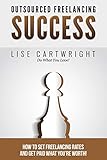Have you ever dreamt of setting your own hours, working from anywhere, and being your own boss? The freelance life offers all of this and more. But one crucial aspect often trips up new freelancers: setting competitive rates. Knowing your worth and charging appropriately is vital for both your financial well-being and your professional reputation. So, how do you strike the right balance? This article will guide you through the process of setting competitive freelance rates that attract clients while valuing your skills and experience.
Understanding the Freelance Marketplace
Before diving into numbers, it’s essential to understand the freelance landscape. Think of it like a bustling farmers market. Various vendors sell similar products, but quality, presentation, and customer service differentiate them. Similarly, in freelancing, your skills are your product. Researching the “going rate” for your services is crucial.
Researching Your Niche
Start by researching your specific niche. Are you a writer, graphic designer, web developer, or nutrition coach like myself? Each field has its own pricing norms. Explore freelance platforms like Upwork and Fiverr to see what others with similar experience are charging. Don’t solely rely on these platforms, as they often represent the lower end of the pricing spectrum.
Analyzing Competitive Rates
Analyze the rates of freelancers who inspire you or whose work you admire. Look beyond just the hourly or project rate. Consider their experience, client testimonials, and portfolio quality. Remember, a higher price often reflects greater expertise and value delivered. As a nutritionist, I often tell my clients that quality ingredients are worth the investment, and the same applies to your freelance services.
 Competitive Freelance Rates
Competitive Freelance Rates
Factors Influencing Your Rates
Several factors play a role in determining your competitive freelance rates. Ignoring these can lead to underselling yourself or pricing yourself out of the market.
Experience and Expertise
Your experience is a valuable commodity. As you gain expertise and a proven track record, your rates should reflect that growth. Just as I wouldn’t charge the same rate I did eight years ago, you shouldn’t undervalue your accumulated knowledge.
Project Complexity and Scope
Not all projects are created equal. A complex project requiring specialized skills will naturally command a higher rate than a simpler task. Clearly define the project scope upfront to avoid scope creep and ensure fair compensation.
Market Demand and Competition
Market dynamics influence pricing. If your skills are in high demand and supply is low, you can command higher rates. Conversely, in a saturated market, competitive pricing is key.
Location and Cost of Living
Your location also plays a role. Living in a high-cost area justifies higher rates compared to someone in a lower-cost region.
Pricing Strategies for Freelancers
There are several pricing models you can adopt. Choosing the right one depends on your niche and project type.
Hourly Rates
Hourly rates are common for ongoing projects or tasks with uncertain scopes. Track your time diligently to ensure accurate billing.
Project-Based Pricing
Project-based pricing works well for defined deliverables. Estimate the time involved and calculate your rate accordingly.
Value-Based Pricing
Value-based pricing focuses on the value you deliver to the client. This model often results in higher earnings but requires clearly articulating the benefits you offer.
Package Pricing
Packaging your services into tiered offerings provides clients with choices and can increase overall revenue.
Negotiating Your Rates
Negotiating rates is a normal part of freelancing. Be prepared to justify your pricing by showcasing your value proposition. Remember, negotiation is a two-way street. Find a mutually agreeable price that benefits both you and the client. “A successful negotiation is a win-win situation,” a mentor once told me.
Regularly Reviewing and Adjusting Your Rates
The freelance market is dynamic. Regularly review and adjust your rates to stay competitive. As you gain experience and build your portfolio, don’t be afraid to raise your prices. Just as I adjust my meal plans based on my clients’ progress, you should adapt your rates to reflect your evolving value.
 Freelancer Negotiating Rates
Freelancer Negotiating Rates
- Briggs, Laura (Author)
- English (Publication Language)
- Riccio-Ackerman, Giovanni Michael (Author)
- English (Publication Language)
- Berktold, Maximilian (Author)
- English (Publication Language)
- Cartwright, Lise (Author)
- English (Publication Language)
- Cartwright, Lise (Author)
- English (Publication Language)
- Cartwright, Lise (Author)
- English (Publication Language)
- Amazon Kindle Edition
- Cartwright, Lise (Author)
- OMER, SYED (Author)
- English (Publication Language)
- Kendall Leif (Author)
- English (Publication Language)
- Amazon Kindle Edition
- White, Paul Allen (Author)
Conclusion
Setting competitive freelance rates is an ongoing process. By understanding the market, valuing your skills, and choosing the right pricing strategy, you can build a thriving freelance career. Remember to regularly review and adjust your rates as you grow and evolve. Don’t be afraid to negotiate and stand your ground. Your skills and expertise are valuable assets. Now go out there and command what you’re worth! Share your thoughts and experiences in the comments below. What strategies have worked for you in setting your freelance rates?











